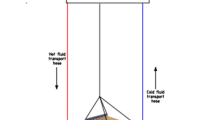Abstract
The phase change characteristic of the power source of an underwater glider propelled by the ocean’s thermal energy is the key factor in glider attitude control. A numerical model has been established based on the enthalpy method to analyze the phase change heat transfer process under convective boundary conditions. Phase change is not an isothermal process, but one that occurs at a range of temperature. The total melting time of the material is very sensitive to the surrounding temperature. When the temperature of the surroundings decreases 8 degrees, the total melting time increases 1.8 times. But variations in surrounding temperature have little effect on the initial temperature of phase change, and the slope of the temperature time history curve remains the same. However, the temperature at which phase change is completed decreases significantly. Our research shows that the phase change process is also affected by container size, boundary conditions, and the power source’s cross sectional area. Materials stored in 3 cylindrical containers with a diameter of 38mm needed the shortest phase change time. Our conclusions should be helpful in effective design of underwater glider power systems.
Similar content being viewed by others
References
STOMELL H. The slocum mission[J]. Oceanography, 1989, 2(1): 22–25.
WEBB D C, SIMONETTI P J, JONES C P, et al. An underwater glider propelled by environmental energy[J]. IEEE Journal of Oceanic Eng, 2001, 26(4): 447–452.
SHERMAN J, DAVIS R E, OWENS W B, et al. The autonomous underwater glider “Spray”[J]. IEEE Journal of Oceanic Eng, 2001, 26(4): 437–446.
CHARLES C. ERIKSEN T. JAMES O, RUSSELL D, et al. Seaglider: A long-range autonomous underwater vehicle for oceanographic research[J]. Journal of Oceanic Eng, 2001, 26(4): 424–436.
WEBB D. C, SIMONETTI P J. The slocum AUV: an environmentally propelled underwater glider[A]. Proc 11th Int Symposium on Unmanned Unsheltered submersible Technology[C]. USST, Durham, 1999.
ZIVKOVIC B, FUJII I. An analysis of isothermal phase change of phase change material within rectangular and cylindrical containers[J]. Solar Energy, 2001,70(1):51–61.
VYSHAK N. R, JILANI G, Numerical analysis of latent heat thermal energy storage system[J]. Energy Conversion and Management, 2007, 48(7): 2161–2168.
LAMBERG P, LEHTINIEMI R, HENELL A M. Numerical and experimental investigation of melting and freezing processes in phase change material storage[J]. International Journal of Thermal Sciences, 2004, 43: 277–287.
FELIX REGIN A, SOLIANKI S C, SAINI J S, Latent heat thermal energy storage using cylindrical capsule: Numerical and experimental investigations[J]. Renewable Energy, 2006, 31: 2025–2041.
KAN Yanbing, ZHANG yinping. A simple model for heat transfer analysis of shell-and-tube with phase change material and its performance simulation[J]. Acta Energiae Solaris Sinica, 1999, 20(1): 20–25(in Chinese).
KE Xiufang, ZHANG Renyuan. Analysis of solicitation process in metal energy storage cylinder[J]. New Energy, 2000, 22(3): 23–27(in Chinese).
WANG Shuxin, WANG Yanhui. Design and trial on an underwater glider propelled by thermal engine[J]. Ocean technology, 2006, 25(1): 1–5(in Chinese).
HOU Shengzhi. Study on working principle of drive-device of AUV propelled by temperature difference energy[D].Tianjin: Tianjin University, 2003(in Chinese).
ZHANG Yinping. Energy Storage in PCM-theory and application[M]. Hefei: University of Science and Technology of China Press, 1996. (in Chinese).
Author information
Authors and Affiliations
Additional information
Foundation item: Supported by the Sustainable Energy Propulsion System Program of 211’s Engineering Foundation, Shanghai Jiaotong University.
KONG Qiao-ling was born in 1974. She is a Ph.D candidate of Shanghai Jiaotong University. Her current research interests include sustainable energy and underwater glider.
MA Jie was born in 1946. He is a professor and a Ph.D student supervisor of Shanghai Jiaotong University. The current research interests include power plant and its automation, intellectualization of marine engines, sustainable energy resources.
Rights and permissions
About this article
Cite this article
Kong, Ql., Ma, J. Phase change analysis of an underwater glider propelled by the ocean’s thermal energy. J. Marine. Sci. Appl. 6, 37–43 (2007). https://doi.org/10.1007/s11804-007-7034-0
Received:
Published:
Issue Date:
DOI: https://doi.org/10.1007/s11804-007-7034-0




